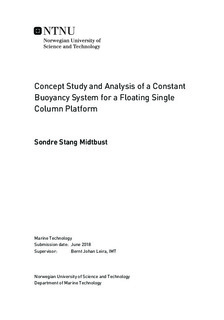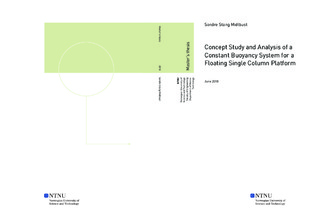| dc.description.abstract | The main objective of this thesis is to study a new platform concept which utilizes a submerged air volume for maintaining constant buoyancy. The work is motivated by the possible application as pontoons for floating bridges or as offshore platforms, where both areas of application can benefit if the vertical motion is reduced. A review of existing and future plans for marine bridges are presented at the beginning of the thesis and serve as an introduction to one of the possible areas of applications. Loads acting on such bridges are described, and methods for analysing the static and dynamic response of floating bridge pontoons are elaborated.
Since the concept employs a submerged air volume, relevant thermodynamic aspects for mathematical modelling of air is elaborated. The main purpose of the concept is to maintain a constant global vertical position. This could be achieved by maintaining a constant displaced volume, i.e., constant buoyancy. The system for maintaining constant buoyancy can be described as follows: When the water level at the column of the structure rises, the total displaced volume will increase. Simultaneously, the increase in water level leads to an increase in hydrostatic pressure felt by a submerged air volume confined in a canister beneath the structure. This air volume is then compressed, resulting in a decrease of total displaced volume.
The submerged air cannot be modelled directly by the software used in this thesis. Therefore, three versions of the same platform model are created using the software GeniE. These models represent three different quasi-static pressure states for the compressed air, where the water-air boundary inside the air canister is modelled as a fixed plate at three different positions. By having consistent mass for all models, their hydrostatic equilibrium position can be determined. Based on these results, the hydrostatic pressure on the air-water boundary plate inside the air canister is calculated.
The three pressure points derived is then linearized onto a pressure-volume diagram for air. When assuming an isotherm compression/expansion process of the air, a linearized pressure-volume relationship is determined. The linear relationship between pressure and volume is rewritten into a linear force-displacement relationship, and a constant stiffness contribution from the air is calculated.
Frequency-domain analysis of the response is performed in WADAM for all three models, and the results show minor differences. The results for surge and pitch motion exposes a model deficiency which makes time-domain analysis in six degrees of freedom a challenge. However, time-domain analysis of the heave response in regular waves can be investigated. The WADAM results for the middle model, which is considered as the initial state, is imported to SIMA and MATLAB for time-domain analysis.
Time-domain analysis of the response is performed in SIMA for frequencies where the system of six degrees of freedom is stable. Supplementary MATLAB simulations for one degree of freedom are performed for other frequencies. In low-frequency regular waves, the results show a decrease in heave motion when applying the modified air-contributed stiffness compared to normal hydrostatic stiffness. For higher frequencies, the effect is opposite, and the modified stiffness results in higher response amplitudes. This result could indicate that when reducing the effect from the air into a simplified linearized spring, one of the consequences will be to increase the natural frequency in heave for the complete system, resulting in larger response amplitude at these frequencies.
Despite some drawbacks in the analysis procedure, the study has uncovered several challenges associated with the constant buoyancy concept. It is plausible that many of the assumptions made in this thesis over-simplification of the actual effects of the air, and further investigations are required before a final conclusion can be made. | en |

